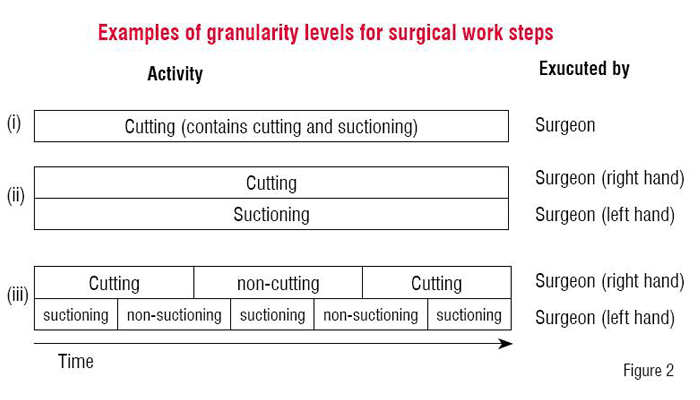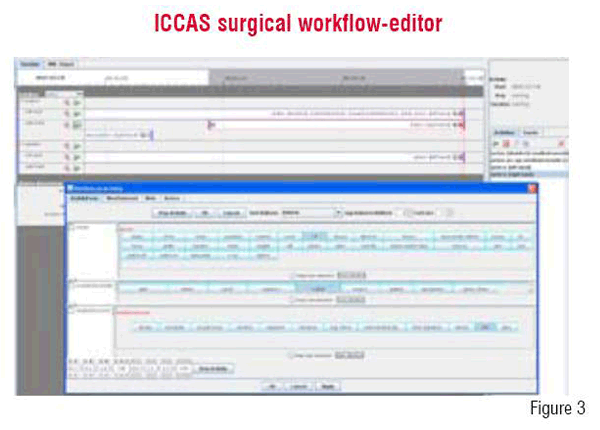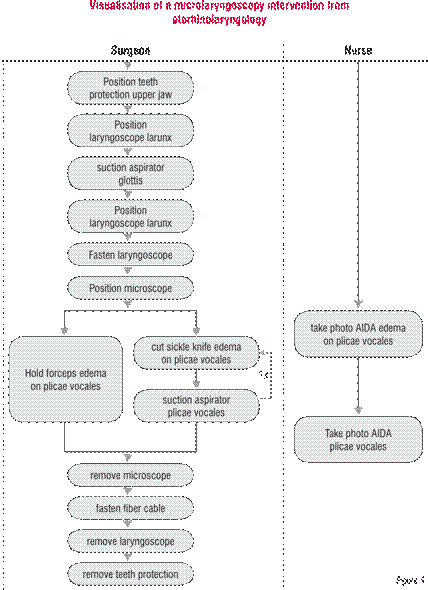Given a great demand for a rigorous analysis of surgical interventions, Surgical Workflow Analysis proves to be a powerful methodology to understand and describe surgical procedures.
The performance of today’s business processes is strongly supported by information systems. Constant adaptation of the business processes to market requirements is achieved by business process analysis and optimisation.
Until now, it was not possible to analyse surgical and intraoperative interventions for optimisation potentials and to support their execution by information systems. Reasons for this were the high variability of surgical processes caused by patient-specific properties, lack of methods for structured description of surgical processes as well as missing data acquisition methods.


The investigation of surgical workflows is an innovative approach for describing surgical interventions. Based on a rigorous Surgical Process Analysis, the acquired data can be used to optimise surgical procedures, to guide the development of new surgical assist systems or to compare different surgical approaches.
The term ‘Surgical workflow’ relates to the description of surgical intervention courses. Surgical workflow is an abstraction of the surgical procedure. Its descriptions are useful for several user groups including surgeons, health administrators, or medical engineers. To use surgical workflows, e.g. for analysis, it is necessary to describe them in a formal language.
Characteristic for Surgical Workflows is the high amount of potentially useful information. However, the choice of the suitable sampling of information restricts, which surgical questions might be answered by the help of surgical workflows. A simple surgical question such as “Who is doing what and when?” results in highly complex descriptions and large amount of information to be processed.
One objective of the work of the Innovation Center Computer Assisted Surgery (ICCAS) at the Universität Leipzig, Germany, is to use Surgical Workflow Analysis to find answers to typical questions arising during optimisation of surgical interventions: “Does using an intraoperative navigation system is more time-saving then the conventional approach without the system?”, “Surgeon A has less complications than surgeon B for similar cases. What’s the difference between both approaches?” or “Will the investment in the development of a new surgical tool pay off for my company? Will it bring significant benefit?”
When applying surgical workflow methods, three subsequent steps are to be performed:

The most important step in each and every study is to acquire a solid data base. There are established methods in nearly every scientific field for measuring each and every aspect, but in surgery one has to rely on the verbal description of intervention courses given by experienced surgeons. Even though structure interviews are a valuable tool during a Surgical Workflow Analysis, we strongly recommend to record real surgical interventions. The data recorded is more accurate and steps which might be forgotten by the expert since they are ‘unimportant’ or ‘well known by everyone’ will be captured.
Since the amount of information which could be recorded during a surgical intervention is enormous, we developed dedicated software for structured recording of surgical interventions: The surgical workflow editor. The manifold of possible questions for surgical workflow analyses needs data acquisition methods with high flexibility, therefore, the software can be customised by anontology to support every possible surgical intervention.
The surgical workflow editor is a software application running on a tablet PC which is operated by trained medical staff for data acquisition. Using human observers adds additional flexibility to the recording process since the observer can move around or ask questions. Observer-based recording reaches its limitations if a high amount of detailed information needs to be recorded or surgical work steps are performed with high frequency.
For structuring surgical interventions, basic considerations need to be made regarding the desired granularity of the observations. In the next section, an approach for segmenting surgical interventions in surgical worksteps with different granularity levels is presented and an information model for acquiring surgical work step information is shown.
How can a surgical work step be modelled? If, for instance hemorrhages are caused by the surgeons while cutting tissue, the blood needs to be suctioned in parallel to the cutting of the tissue. This simple step might be considered and described under various viewpoints and granularity levels (cp. Figure 2):
(i) A work step “Cutting” is defined, that consists of the sub work steps cutting and suctioning, performed as smallest atomic unit by the surgeon.
(ii) A second choice would be the definition of cutting and suctioning as two independent working units, performed by the “Left hand of the surgeon” and the “right hand of the surgeon” as atomic organisational units.
(iii) A third option would be the consideration of the work steps of one hand with the temporal segmentation “suctioning-non-suctioning-suctioning”. This granularity level shows a further segmentation of (ii) and considers short breaks by pausing suctioning by the surgeon.
The choice of the granularity level reveals a further challenge: the relation of temporal and causal coherency. If the choice (i) is made, the work step ‘cutting’ contains implicitly the work step ‘suctioning’ for supporting the cutting work step. A granularity level according to (ii) requires in contrast an explicit representation of the suctioning, which is performed in parallel to the cutting. If the surgeon suctions at another location at the same time, when he cuts, both work steps have a temporal, but no causal relation, because then the suctioning was not necessary caused by the cutting. Considering granularity level (iii), between the work steps ‘suctioning’ and ‘non-suctioning’ exists a causal, but no temporal and parallel relation, because both work steps cannot be performed by the surgeons hands at the same time.
If the objective of the observation is a more detailed recording, a consideration of the performed work steps at least at granularity level (ii) is necessary. Recording surgical procedures on such level of detail is a demanding task. For example, if work steps of the assistant or the scrub nurse should be acquired in addition to the work steps performed by the surgeon, the number and frequency of activities can not be handled without software support. For this objective, the Surgical Workflow Editor was developed. With the help of the software, detailed information of procedure courses can be acquired and analysed for clinical questions. Figure 3 shows a screenshot of the Surgical Workflow Editor. The frame in the foreground is used to enter a new surgical activity or an event. The intervention course containing all work steps is visualised in the background.
After recording, the SPM can be analysed. Statistical methods can be applied to count occurrence of certain activities or instrument usage, or to analyse the duration of certain phases of the intervention. For exploration of several recorded processes or interdisciplinary discussion about an intervention, a graphical representation of the SPM is helpful. Figure 4 shows a visualisation of an intervention protocol for a surgical intervention of the type Microlaryngoscopy from Otorhinolaryngology. This visualisation is automatically generated from a SPM and can even be displayed in parallel to the intervention course e.g. for live transmissions of surgical interventions during conferences. The visualisation of a surgical workflow, which contains all possible variations of a certain intervention type, is more challenging. We developed different methods for visual exploration of process graphs to provide good support for non-technical people working with the surgical workflow.
To evaluate the surgical workflow editor, it was applied to several intervention types from multiple disciplines. These included intervention types form otorhinolaryngology, neurosurgery, cardiovascular surgery, interventional radiology, and eye surgery. Intervention courses have been recorded at international sites in Germany, France and the US. The methodology has been used in many ways, for example to optimise patient pathways, to compare different surgical approaches, to compare different surgical devices, for the development of use cases for an international standardisation body, or for generating educational material.
Surgical workflow analysis is a powerful tool to understand and describe surgical procedures at a formerly unknown level of detail. The methods for recording surgical processes are effective and applicable to surgical routine without major restrictions. Statistical and visual exploration of recorded SPMs are a powerful method to select from the large amount of available information, the most relevant ones for answering a specific surgical question. In the future, workflow management systems will be used to support the surgeon during the intervention, for example by providing the information needed during a specific step. Basic research providing the necessary situation awareness and automated process recording is currently being performed in several research institutions all over the world.